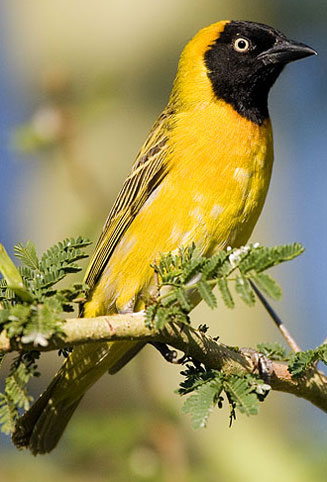|
Ploceus intermedius (Lesser
masked-weaver)
Kleingeelvink [Afrikaans]; umZwingili [Zulu]; Kambara
(generic term for weaver) [Kwangali]; Jesa (generic name for weaver) [Shona]; Ndzheyana (generic term for weaver or
quelea) [Tsonga]; Thaga
(generic term for weaver) [Tswana]; Kleine textorwever [Dutch]; Tisserin
intermédiaire [French]; Cabanisweber [German];
Tecelão-pequeno-de-mascarilha [Portuguese]
Life
> Eukaryotes >
Opisthokonta
> Metazoa (animals) >
Bilateria >
Deuterostomia > Chordata >
Craniata > Vertebrata (vertebrates) > Gnathostomata (jawed
vertebrates) > Teleostomi (teleost fish) > Osteichthyes (bony fish) > Class:
Sarcopterygii (lobe-finned
fish) > Stegocephalia (terrestrial
vertebrates) > Tetrapoda
(four-legged vertebrates) > Reptiliomorpha > Amniota >
Reptilia (reptiles) >
Romeriida > Diapsida > Archosauromorpha > Archosauria >
Dinosauria
(dinosaurs) > Saurischia > Theropoda (bipedal predatory dinosaurs) >
Coelurosauria > Maniraptora > Aves
(birds) > Order: Passeriformes
> Family: Ploceidae > Genus: Ploceus
 |
 |
|
Lesser masked-weaver male. [photo
Tony Faria
©] |
Lesser masked-weaver male, North-West Province,
South Africa. [photo Johann Grobbelaar
©] |
Distribution and habitat
Occurs from Ethiopia through Kenya, Tanzania, Zambia and
Angola to southern Africa. Here it is locally common across the northern half of
the region, from northern Namibia to Mozambique and north-eastern South Africa,
generally prefering habitats with or close to water, such as Acacia
savanna, open woodland, riverine trees, reedbeds, swamps and mangroves.
|
 |
|
Distribution of Lesser-masked weaver in southern Africa,
based on statistical smoothing of the records from first SA Bird Atlas
Project (©
Animal Demography unit, University of
Cape Town; smoothing by Birgit Erni and Francesca Little). Colours range
from dark blue (most common) through to yellow (least common).
See here for the latest distribution
from the SABAP2. |
Predators and parasites
It (at different stages of development) has been recorded
as prey of the following animals:
Brood parasites
It has been recorded as host of the
Diderick
cuckoo.
Food
It mainly eats insects (especially caterpillars) and
nectar, doing most of its foraging in the tree canopy, gleaning prey from
foliage and flowers. The following food items have been recorded
in its diet:
- Insects
- Plants
- nectar
- Aloe
- Albizia
- Morus (mulberries)
- small seeds
- maize porridge (taken from gardens)
Breeding
- Polygynous, as males mate with multiple females in a breeding season,
living in colonies of 20-30, rarely up to 200 nests (see image on the bottom
right)
- The nest is built solely by the male, consisting of a sturdy but
thin-walled kidney-shaped structure, with a downward-pointed entrance
tunnel. It is usually made of narrow strips of grass, reeds or palm leaves
and, if accepted by the female, she lines the interior with silky grey
fibres. It is typically placed at the end of a branch, in the foliage of a
tree or bush, in a patch of reeds, at the edge of a roof or suspended from a
telephone wire.
- Egg-laying season is from August-March, peaking from October-January.
- It lays 2-4 eggs, which are incubated solely by the female for about 13
days.
- The chicks are mainly brooded and fed by the female, leaving the nest
after about 15-16 days.
Threats
Not threatened.
References
-
Hockey PAR, Dean WRJ and Ryan PG 2005. Roberts
- Birds of southern Africa, VIIth ed. The Trustees of the John Voelcker
Bird Book Fund, Cape Town.
|
